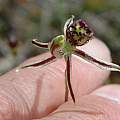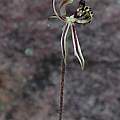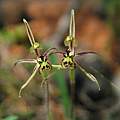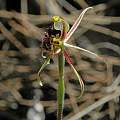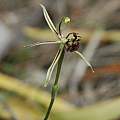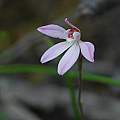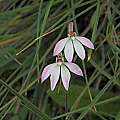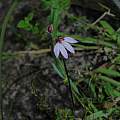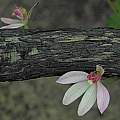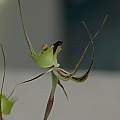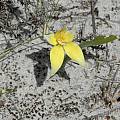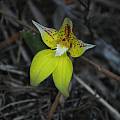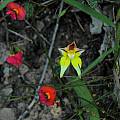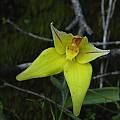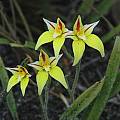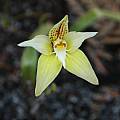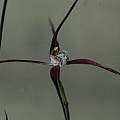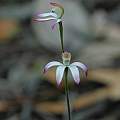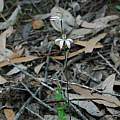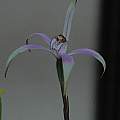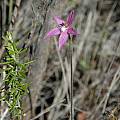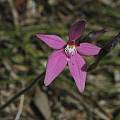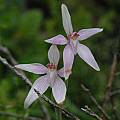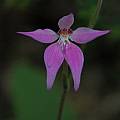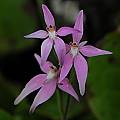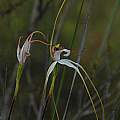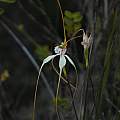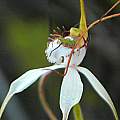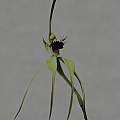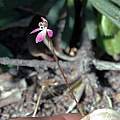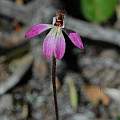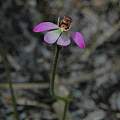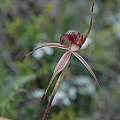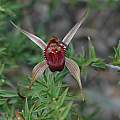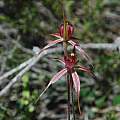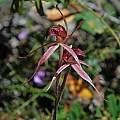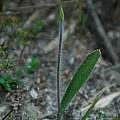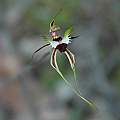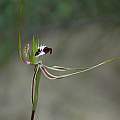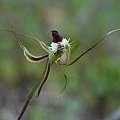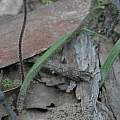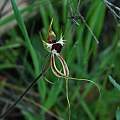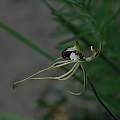Caladenia R.Br., an Orchidaceae genus, includes tuberous terrestrial orchids that occur mostly in Australia although there are a few from New Zealand and another that extends to New Caledonia, Indonesia and Malaysia. The scientific name is derived from the Greek words calos (meaning beautiful) and aden (meaning glands), referring to the colorful labellum and the glistening glands at the base of the column that adorn many of the species. They usually have hairy stems and leaves and a solitary generally linear or oblong leaf. The flowers have widely spreading sepals and petals (excluding the labellum). The spider orchids have very long sepals and petals that are often yellowish, whereas the other species have smaller flowers that are often white to pink. There are natural hybrids. Depending on which authority you accept this is either a very large genus or a very small genus. In 2001 DL Jones, MA Clements, IK Sharma, and AM Mackenzie in a paper entitled A new classification of Caladenia R.Br. (Orchidaceae) proposed breaking this genus into six species: Caladenia, Arachnorchis, Drakonorchis, Jonesiopsis, Petalochilus, and Stegostyla. This was not widely accepted. Others considered some of these proposed genera as subgenera, but not necessarily with the same name. Identification of an already large genus is very challenging since there can be multiple names for the same plant depending on the authority consulted. Further taxonomic work by MA Clements, CG Howard CG1, and JT Miller published in 2015 concluded that none of the current taxonomic treatments were satisfactory. Their work did not support recognition of Arachnorchis, Cyanicula, Drakonorchis, Ericksonella, Jonesiopsis, Petalochilus, Pheladenia, and Stegostyla as previously proposed. They suggested a return to Lindley's concept of Caladenia (1830-1840) but also including Glossodia and Elythranthera. Their suggestion includes around 301 species with five subgenera: Pheladenia, Glossodia, Pentisea, Trilobatae, and Caladenia. We are including the synonyms for those 2001 proposed changes.
The Species Orchid Society of Western Australia hosts a lot of information online about Australian orchids here.
The Australian terrestrial orchids are notoriously challenging to grow, although some enthusiasts are starting to achieve success by cultivating the symbiotic fungus that many of the orchids require in order to grow. Very careful fertilization is required to keep the fungus and orchid in balance. There's a good discussion of the relationship by clicking on mycorrhiza here.
Caladenia barbarossa Rchb.f. known as the common dragon orchid was named Drakonorchis barbarossa (Rchb.f.) D.L.Jones & M.A.Clem. in the 2001 paper. It is found in well-drained to moist soils in many shrubby and forested habitats. It has a hairy basal leaf and a single flower that is greenish with red markings and a wide hairy lip that looks like a female thynnid wasp. Height range: 10-30 cm. The plants photographed below were growing under she-oaks near a river bed in the Stirling Range National Park. We saw quite a number of them in this habitat. Photographs were taken September 2007 by Bob Rutemoeller and Mary Sue Ittner.
Caladenia brunonis (Endl.) Rchb.f., see Elythranthera brunonis (Endl.) A.S.George
Caladenia carnea R.Br. was included in the "Fingers" group by Jones and Clements as Petalochilus carneus (R.Br.) D.L.Jones & M.A.Clem. Known as Pink Fingers, it occurs in almost all Australian states, New Zealand, New Caledonia, Indonesia and Malaysia. It is very variable in size (5 cm to 25 cm high) and color ranging from white to pale pink to deep pink. It occurs in many different habitats. The rear sepal is erect and the four other segments spread forwards like the fingers of a hand. It has 1 to 4 flowers on a wiry scape that are 2 to 3 cm across. The lip has dark red bars and two rows of yellow calli. Photographs taken October 2007 in the Grampians by Mary Sue Ittner.
Caladenia emarginata (Lindl.) Rchb.f. see Elythranthera emarginata (Lindl.) A.S.George
Caladenia falcata (Nicholls) M.A.Clem. & Hopper was named Arachnorchis falcata (Nicholls) D.L.Jones & M.A.Clem. in the 2001 paper. Part of the "Spider Orchid" group, it is known by the common name of Fringed Mantis Orchid. It is native to Western Australia where it grows in well-drained soil in woodland, shrubland and on granite outcrops, often under she-oaks. Flowers are greenish to greenish-yellow with red stripes and markings. Petals curve backwards while the lower sepals curve forward. The lip is green and fringed with maroon calli and apex. Height range: 20-40 cm. Photo by Bob Rutemoeller labeled as this species at a flower show in Albany September 2007.
Caladenia flava R.Br., commonly known as the Cowslip Orchid, was not changed by Jones and Clement. It is a Western Australian species with a hairy leaf and yellow flowers of various shades and red dots and stripes on the upper segments. Flowers are large, up to 4.5 cm in diameter, with plants less than 30 cm high. This species is widespread, sometimes found in dense colonies in forested and shrubby habitats in well drained soils. Photos below taken by Bob Rutemoeller and Mary Sue Ittner in southwestern Western Australia in September 2007 show some of the variations.
Caladenia footeana Hopper & A.P.Br. was named Jonesiopsis footeana (Hopper & A.P.Br.) D.L.Jones & M.A.Clem. in the 2001 paper. It is a member of the group called Daddy Long Legs, known by the common name of crimson spider orchid. It is native to southwestern Western Australia where it is found growing in clay, loam, or gravel in moist areas. It is a terrestrial, perennial, deciduous, herb with an underground tuber. It has a single erect, hairy leaf and one or two dark pinkish-red flowers with maroon markings and a red and white striped labellum borne on a stalk 10–22 cm (4–9 in) high. Flowering occurs from July to early October. Photograph by Mary Sue Ittner of a specimen in a wildflower show in southwestern Australia.
Caladenia gracilis R.Br. was named Stegostyla gracilis (R.Br.) D.L.Jones & M.A.Clem. in the 2001 paper. It is a southeastern Australian species that is strongly scented gaining its common name of Musky Caladenia, or musky caps. It is wide spread in Victoria growing in well drained soils in open forest and woodland or scrubby slopes. It grows up to 45 cm tall and has 1 to 4 flowers on a long pedicel that range from 6 to 40 mm across. Flowers are dusky on the outside and generally white inside. Photographs were taken October 2007 in the Grampians by Bob Rutemoeller and Mary Sue Ittner.
Caladenia hirta Lindl. was named Arachnorchis hirta (Lindl.). D.L.Jones & M.A.Clem. in the 2001 paper. Part of the "Spider" group, it is endemic to Western Australia. This orchid is often referred to as the Sugar Candy Orchid. It is widespread in the southwest in open forests and heathlands of the coast, ranges, and the wheat belt. The one to three large flowers are white or pink. Height range: to about 5 cm.
Caladenia hirta ssp. rosea Hopper & A.P.Br., syn. Arachnorchis hirta(Lindl.). D.L.Jones & M.A.Clem. ssp. rosea (Hopper & A.P.Br.) D.L.Jones & M.A.Clem., is a common inland clumping subspecies with bright pink flowers commonly known as the pink candy orchid. Photo by Mary Sue Ittner labeled as this taxa at a flower show in Albany September 2007.
Caladenia latifolia R.Br. grows in coastal scrub, and heathland. It has broad, bright green hairy leaves which usually lie flat on the ground and bright pink flowers 3 to 3.5 cm across borne on the end of a wiry scape to 40 cm tall. Each flower has an erect rear sepal and the other segments spread forward. This orchid is commonly known as Pink Fairies and is found in a number states in southern Australia. Pictures below were taken in various sites in southwestern Western Australia by Bob Rutemoeller and Mary Sue Ittner September 2007.
Caladenia longicauda Lindl. was named Arachnorchis longicauda (Lindl.) D.L.Jones & M.A.Clem. in the 2001 paper. Known as the Tufting White Spider Orchid, it is found in Western Australia in open grass or low shrubby areas in woodland, usually in well drained soil. It has white flowers with drooping segments, broad at the base and narrowing abruptly to a long slender tip. The lip has a marginal fringe of long teeth and rows of calli. There are many subspecies. The one pictured below was seen in the Stirling Range National Park in September 2007 and could be ssp. eminens which is found there. You can't see the calli since there is a green spider on the lip. We saw it on a bank next to the road and it was late in the day and hard to get close enough to it for a very clear picture. Height range: 1-2 ft. Photos by Mary Sue Ittner.
Caladenia longiclavata E.Coleman was named Arachnorchis longiclavata (E.Coleman) D.L.Jones & M.A.Clem. in the 2001 paper. A member of the spider orchid group it is endemic to the southwest of Australia. It grows to 40 cm tall with an erect stalk. Flowers are green, gold, and deep red. Because the segments are wide at the base contracting to a clubbed tip this orchid is often referred to as the Clubbed Spider Orchid. There are many variations in this species. Photo by Mary Sue Ittner labeled as this species at a flower show in Albany September 2007.
Caladenia major (R.Br.) Rchb.f. see Glossodia major R.Br.
Caladenia minorata M.A.Clem. see Glossodia minor R.Br.
Caladenia polychroma Hopper & A.P.Br. was named Jonesiopsis polychroma (Hopper & A.P.Br.) D.L.Jones & M.A.Clem. in the 2001 paper. It was a member of the Daddy Long Legs group. Known as Joseph's Spider Orchid, is a Western Australia species found in woodlands and displaying a range of colors (white, yellow, orange, red). It has a single erect, hairy leaf and one or two flowers borne on a stalk 20–30 cm (8–10 in) tall. The sepals and petals have long, thin, drooping, thread-like ends and the labellum is cream-colored to yellow with red lines, spots and blotches. The sides of the labellum have short, blunt teeth and the tip is curled under. Flowering occurs from September to October. I believe that this orchid seen in the Stirling Range National Park in late September 2007 could be this species. Some of the segments had been broken off or perhaps been eaten giving it an unusual appearance. Height range: 8-10 in. Photos by Mary Sue Ittner.
Caladenia pusilla W.M.Curtis was included in the "Fingers" group by Jones and Clements as Petalochilus pusillus (W.M.Curtis) D.L.Jones & M.A.Clem. in the 2001 paper. Known as Tiny Fingers, it is a species that is quite small. Height range: 4-10 cm. It is found in southeastern Australian states growing in heathland or open forest in sandy soils. Photographs were taken October 2007 near Apollo Bay by Bob Rutemoeller and Mary Sue Ittner.
Caladenia reticulata Fitzg. was named Arachnorchis reticulata (Fitzg.) D.L.Jones & M.A.Clem. in the 2001 paper. A member of the spider orchid group, this species is found in well-drained soils in shrubby forest in southeastern Australia and is commonly known as the Veined Spider Orchid or the netted caladenia. The one to three 5 cm flowers are yellow or red with red veins and grow on a wiry hairy scape to 30 cm tall. The spreading segments are reminiscent of a spider's legs. Photos were taken by Bob Rutemoeller and Mary Sue Ittner on the Great Ocean Walk near Apollo Bay in heathland.
Caladenia tentaculata Schltdl. was named Arachnorchis tentaculata (Schldl.) D.L.Jones & M.A.Clem. in the 2001 paper. Known by the common name of Eastern Mantis Orchid, it grows in open forest, woodland, and heathland in Victoria and South Australia. It has flowers about 10 cm across that are greenish with crimson stripes and a delicately balanced green white and maroon lip with fringed margins, a maroon apex and maroon calli. It blooms from October to November and is very similar to Caladenia dilatata which is smaller and blooms later. Height: to about 20 cm. Photos below were taken by Bob Rutemoeller and Mary Sue Ittner October 2007 in the Grampians.
